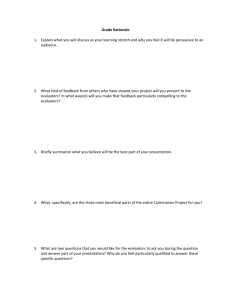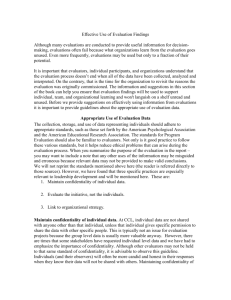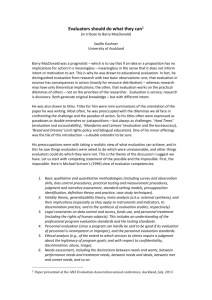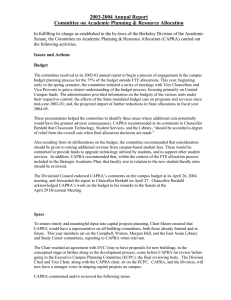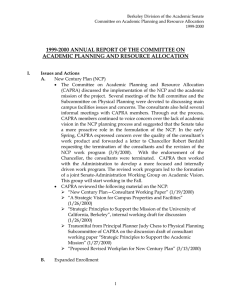The Key Role of Communication Theory in Reporting Evaluation
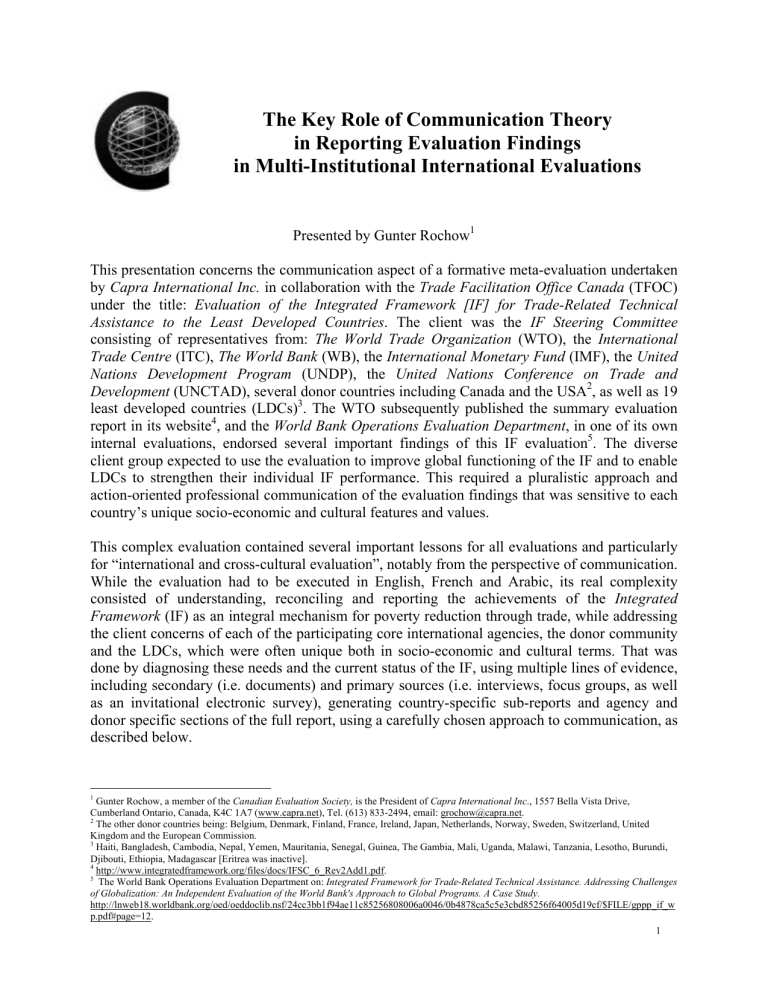
The Key Role of Communication Theory in Reporting Evaluation Findings in Multi-Institutional International Evaluations
Presented by Gunter Rochow 1
This presentation concerns the communication aspect of a formative meta-evaluation undertaken by Capra International Inc.
in collaboration with the Trade Facilitation Office Canada (TFOC) under the title: Evaluation of the Integrated Framework [IF] for Trade-Related Technical
Assistance to the Least Developed Countries . The client was the IF Steering Committee consisting of representatives from: The World Trade Organization (WTO), the International
Trade Centre (ITC), The World Bank (WB), the International Monetary Fund (IMF), the United
Nations Development Program (UNDP), the United Nations Conference on Trade and
Development (UNCTAD), several donor countries including Canada and the USA least developed countries (LDCs) 3
2 , as well as 19
. The WTO subsequently published the summary evaluation report in its website 4 , and the World Bank Operations Evaluation Department , in one of its own internal evaluations, endorsed several important findings of this IF evaluation 5 . The diverse client group expected to use the evaluation to improve global functioning of the IF and to enable
LDCs to strengthen their individual IF performance. This required a pluralistic approach and action-oriented professional communication of the evaluation findings that was sensitive to each country’s unique socio-economic and cultural features and values.
This complex evaluation contained several important lessons for all evaluations and particularly for “international and cross-cultural evaluation”, notably from the perspective of communication.
While the evaluation had to be executed in English, French and Arabic, its real complexity consisted of understanding, reconciling and reporting the achievements of the Integrated
Framework (IF) as an integral mechanism for poverty reduction through trade, while addressing the client concerns of each of the participating core international agencies, the donor community and the LDCs, which were often unique both in socio-economic and cultural terms. That was done by diagnosing these needs and the current status of the IF, using multiple lines of evidence, including secondary (i.e. documents) and primary sources (i.e. interviews, focus groups, as well as an invitational electronic survey), generating country-specific sub-reports and agency and donor specific sections of the full report, using a carefully chosen approach to communication, as described below.
1 Gunter Rochow, a member of the Canadian Evaluation Society, is the President of Capra International Inc ., 1557 Bella Vista Drive,
Cumberland Ontario, Canada, K4C 1A7 (www.capra.net), Tel. (613) 833-2494, email: grochow@capra.net.
2 The other donor countries being: Belgium, Denmark, Finland, France, Ireland, Japan, Netherlands, Norway, Sweden, Switzerland, United
Kingdom and the European Commission.
3 Haiti, Bangladesh, Cambodia, Nepal, Yemen, Mauritania, Senegal, Guinea, The Gambia, Mali, Uganda, Malawi, Tanzania, Lesotho, Burundi,
Djibouti, Ethiopia, Madagascar [Eritrea was inactive].
4 http://www.integratedframework.org/files/docs/IFSC_6_Rev2Add1.pdf.
5 The World Bank Operations Evaluation Department on: Integrated Framework for Trade-Related Technical Assistance. Addressing Challenges of Globalization: An Independent Evaluation of the World Bank's Approach to Global Programs. A Case Study.
http://lnweb18.worldbank.org/oed/oeddoclib.nsf/24cc3bb1f94ae11c85256808006a0046/0b4878ca5c5e3cbd85256f64005d19cf/$FILE/gppp_if_w p.pdf#page=12.
1
“The Key Role of Communication Theory in Reporting Evaluation Findings in Multi-Institutional International
Evaluations”. 2005 Joint CES/AEA Evaluation Conference. Toronto, Ontario (October 28, 2005)
Unless a client specifically asks for only a “diagnostic” assessment, a formative evaluation report should contain an action-planning component, comprising options for improvement as well as formal recommendations. The country-specific reports and the agency and donor components of the detailed IF report were subsequently synthesized into a global summary report.
The need for such synthesis has also been recognized beyond the evaluation community in the professional literature of management consulting. Thus, Milan Kubr (ed.), in Management
Consulting: A Guide to the Profession , states:
Many bulky analytical reports, often based on vast numbers of facts and defining long lists of problems, are difficult to use because they lack synthesis. Key conclusions are not drawn and key measures are not identified. As all the measures proposed cannot be introduced at the same time or with the same vigour, action starts in a haphazard way or is soon abandoned.
6
The IF assignment thus represented a unique communication challenge. How such a challenge is addressed determines to a considerable extent the actions, which the client would ultimately take in response to the evaluation findings.
Boyd Clarke and Ron Crossland stated in their recent book, The Leader’s Voice: How your communication can inspire action and get results!
7 : “Over and over again business leaders make four fatal assumptions concerning their communication. These assumptions are:
• Constituents UNDERSTAND what was communicated;
• Constituents AGREE with what was communicated;
• Constituents CARE about what was communicated; and
• Constituents will take APPROPRIATE ACTION.” [p. 6]
All too often evaluators make the same fatal assumptions. The burden is upon the evaluators to write their reports in such a way that their clients understand, agree with and care about their findings and that they will take appropriate action.
In reporting the findings of the IF evaluation, the evaluators used a classical model known as the
Motivated Sequence , which was first developed by Alan Monroe, then professor at Purdue
University. His book Principles and Types of Speech was first published in 1932, then reissued in 1955 and reissued again in the 1970s, with some enhancements, by Douglas Ehninger, and published again most recently in 1999 8 , under the title: Principles and Types of Speech
Communication . In the 1970s Ehninger added an important chapter applying Monroe’s communication concepts to the political arena. Fundamentally this group of authors stressed that all speeches, and indeed all types of communication calling for action, must use motivators in the context of a sequence that is logical. The logical aspect of Monroe’s sequence comprises five steps:
6 Kubr, Milan (ed.). Management Consulting: A Guide to the Profession (Fourth Edition).Geneva: International Labour Organization, 2002, page
207.
7 Clarke, Boyd and Ron Crossland. The Leader’s Voice: How your communication can inspire action and get results! Select Books, 2002, 169 pp.
Capra International uses this book as the basis for a two-day workshop on The Leader’s Voice . Four other leadership workshops are also offered
(http://www.capra.net/modules.php?name=Services&pa=showpage&pid=10 ). The book can be ordered through: www.amazon.com.
8 Principles and Types of Speech Communication by Douglas Ehninger, Bruce Gronbeck, Alan Monroe, Edition: 14 Pages: 434 Book Format: Hardcover ISBN:0321044258
Date Published: 09/1999 Publisher: Addison Wesley Longman, Inc.
Gunter Rochow, Capra International Inc., 1557 Bella Vista Drive, Cumberland, Ontario, Canada 2
“The Key Role of Communication Theory in Reporting Evaluation Findings in Multi-Institutional International
Evaluations”. 2005 Joint CES/AEA Evaluation Conference. Toronto, Ontario (October 28, 2005)
1. First, the Attention Step, which is critical to assure that the listeners or readers take notice;
2. Second, the Needs Step, which communicates the problem or opportunity that is perceived to be of concern to the listeners and that merits their attention;
3. Third, the Satisfaction Step, which shows how the need can be satisfied or the opportunity exploited;
4. Fourth, the Step, which helps the listener or reader imagine what his or her world would look like, if the necessary action were taken to overcome the problem or to exploit the opportunity; and
5. Fifth, the Step, which invites the listener or reader to take appropriate action. If the speaker is electioneering, he or she would ask for the vote; if fundraising, pass the hat, or if proposing program changes, make appropriate recommendations.
Monroe and his later co-authors, argued that most people do not take action on mere logic, but that what they called a “ logical sequence” must be presented in a manner that appeals to emotion ; hence the “ motivated” sequence. The following statistic may serve as an example of what this means: An evaluator assessing the effectiveness of active labour market programs, may report that in a given province or state the unemployment rate is 20%. How many readers will be motivated to action if the evaluator reports a 20% unemployment rate? Possibly not many of them will make an effort to understand what that means, and much less take any action. What would happen if the evaluator interpreted the statistical data by reporting that unemployment in that province or state is so severe that one out of five children goes to bed hungry because his father or mother does not have a job? Would such a statement be more likely to result in action than the mere statistic of 20% unemployment?
Clarke and Crossland 9 took communication theory one step further, by stating that effective communication not only requires data and emotion , but also symbolism . An evaluation report using this communication triad would thus contain not only the customary data and an interpretation of the data in a way that speaks to the heart, but also symbols, images, perhaps graphs or photos 10 about the field of investigation.
Monroe’s five steps were used throughout the IF Evaluation report, especially the country-specific sub-reports, in the following manner:
In the Attention Step , the evaluators attempted to identify the mandate, unique institutional and country contexts, including a country’s unique socio-economic and cultural features and values, as well as the evaluation methodology and the findings of the evaluation.
9 Ibid ., p. 8
10 Source of the photo on this page: www.et.undp.org/ poverty/poverty.htm.
Gunter Rochow, Capra International Inc., 1557 Bella Vista Drive, Cumberland, Ontario, Canada 3
“The Key Role of Communication Theory in Reporting Evaluation Findings in Multi-Institutional International
Evaluations”. 2005 Joint CES/AEA Evaluation Conference. Toronto, Ontario (October 28, 2005)
In the Needs Step , the evaluators pointed out why particular problems or opportunities described in the evaluation findings were considered to be important to the client in the context of the evaluation mandate, normally with reference to the unique institutional and country needs.
In the Satisfaction Step , the evaluators outlined approaches, which the client might choose to use to overcome the problems or to exploit the opportunities that had been identified in the evaluation.
In the Visualization Step , the evaluators invited the clients and their stakeholders to imagine how their world might change in their favour, if they should decide to take action on the recommended approaches. In particular, they were stimulated to imagine what impact on poverty their action might have, how they might develop justifiable pride, achieve a sense of power and merited recognition for their effective leadership.
In the Action Step the evaluators presented their formal recommendations for action, initially on an institution and country-specific basis, and then in integrated global fashion for the Integrated
Framework as a whole.
It should be noted that many evaluation reports seem to jump from what is contained in the
Attention Step directly to the Action Step , i.e. they jump from a description of the mandate, the methodology and the evaluation findings directly to the recommendations. Do you think that that is a good idea? If not, could such reports be improved by adding the Needs , Satisfaction and
Visualization Steps, i.e. by explaining what the problems or opportunities might mean for the client, how the problems might be resolved and opportunities exploited, how their unique institutional or country-specific world might change if they took the recommended action? If evaluators were to do that before they proceed to the Action Step, would it be likely that their formal recommendations would be better understood, and for that reason, be acted upon?
Let us now assume that what I have said so far in this brief presentation equates to Monroe’s first three steps in the motivated sequence. What would I have to do to make the motivated sequence of my presentation complete? I would need to take my own Visualization and Action steps.
Let us try this on as my Visualization Step. Imagine that you will try some of these approaches in your evaluation reporting. Would using the motivated sequence help you in becoming a more effective reporter of evaluation findings? Would it lead to greater client satisfaction and perhaps to more repeat business? Would it strengthen your client’s ability to take effective action? Would it enhance your image of yourself as a communicator? Would you feel more powerful and in control? Would you feel really good about yourself and your role in life? Would this help you to achieve self-actualization , to use the ultimate degree of motivation in Abraham Maslow’s famous hierarchy?
And, finally, here is my Action Step: Is there a single reason why you would not want to use these communication approaches in reporting on your evaluations? If so, let us hear it, as we open up the floor for questions. If not, I urge you to try to use the five steps of the motivated sequence in your next report. You may be happy that you did. Thank you
Gunter Rochow, Capra International Inc., 1557 Bella Vista Drive, Cumberland, Ontario, Canada 4
